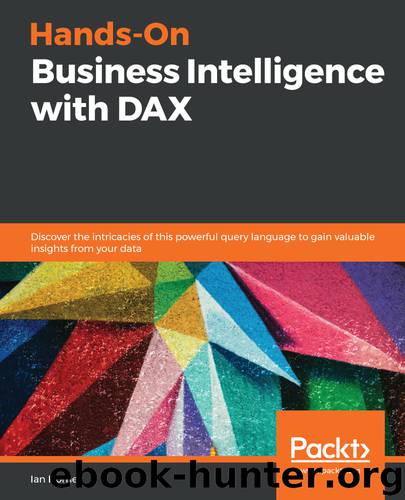Hands-On Business Intelligence with DAX by Ian Horne

Author:Ian Horne [Ian Horne]
Language: eng
Format: epub
Tags: COM051380 - COMPUTERS / Programming / Microsoft, COM018000 - COMPUTERS / Data Processing, COM005030 - COMPUTERS / Enterprise Applications / Business Intelligence Tools
Publisher: Packt
Published: 2020-01-31T04:17:21+00:00
We've gone through the function types and groups in this section. In the next section, we will learn about the aggregation functions.
Introduction to aggregation functions
As we have already seen earlier in this chapter, the DAX language consists of a large number of functions that can be grouped based on the type of functionality they provide. In this section, we are going to take our first detailed look at these groups, starting with a look at the aggregation group of functions.
Aggregation functions provide a way to summarize or group data and common examples include the AVERAGE, COUNT, MAX, MIN, and SUM functions. All of these have their equivalent X function, such as SUMX. Instead of working against a column of a table, these X functions apply the aggregation to the result of an expression that is evaluated for each row of a table.
Download
This site does not store any files on its server. We only index and link to content provided by other sites. Please contact the content providers to delete copyright contents if any and email us, we'll remove relevant links or contents immediately.
| NET | C & C++ Windows Programming |
| SQL Server | VBA |
| Visual Basic |
The Mikado Method by Ola Ellnestam Daniel Brolund(20603)
Hello! Python by Anthony Briggs(19899)
Secrets of the JavaScript Ninja by John Resig Bear Bibeault(18208)
Dependency Injection in .NET by Mark Seemann(18108)
The Well-Grounded Java Developer by Benjamin J. Evans Martijn Verburg(17575)
OCA Java SE 8 Programmer I Certification Guide by Mala Gupta(17421)
Kotlin in Action by Dmitry Jemerov(17183)
Adobe Camera Raw For Digital Photographers Only by Rob Sheppard(16930)
Algorithms of the Intelligent Web by Haralambos Marmanis;Dmitry Babenko(16234)
Grails in Action by Glen Smith Peter Ledbrook(15390)
Test-Driven iOS Development with Swift 4 by Dominik Hauser(10393)
Becoming a Dynamics 365 Finance and Supply Chain Solution Architect by Brent Dawson(8055)
Microservices with Go by Alexander Shuiskov(7818)
Practical Design Patterns for Java Developers by Miroslav Wengner(7718)
Test Automation Engineering Handbook by Manikandan Sambamurthy(7671)
Angular Projects - Third Edition by Aristeidis Bampakos(7159)
The Art of Crafting User Stories by The Art of Crafting User Stories(6611)
NetSuite for Consultants - Second Edition by Peter Ries(6533)
Demystifying Cryptography with OpenSSL 3.0 by Alexei Khlebnikov(6305)
